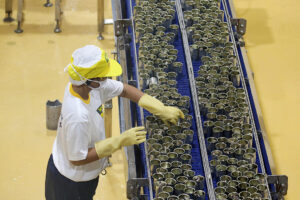




Policy Rate Updates: Double cut finale
 DOWNLOAD
DOWNLOAD

Monthly Economic Update: One for the road
 DOWNLOAD
DOWNLOAD

Inflation Update: Still low, still slow
 DOWNLOAD
DOWNLOAD


Factory output up for 8th month in a row in January

FACTORY OUTPUT rose for the eighth straight month in January as the economy further reopened, the Philippine Statistics Authority (PSA) reported on Thursday.
Preliminary results of the PSA’s latest Monthly Integrated Survey of Selected Industries (MISSI) showed factory output, as measured by the volume of production index (VoPI), expanded by 10.6% year on year in January.
This was faster than the revised 4.2% growth seen in December, but lower compared with the 10.9% in January 2022.
The January print was the eighth consecutive month that the VoPI posted a positive reading. It was also the fastest growth in 10 months or since the 346.1% surge in March last year.
“Continued reopening of the economy bodes well for factory output and production. Just like recent PMI readings, output sustained expansion but at a more moderate pace as input costs rose and supply chain issues worsened,” ING Bank N.V. Manila Senior Economist Nicholas Antonio T. Mapa said in an e-mail.
The Philippines’ manufacturing Purchasing Managers’ Index (PMI) continued to expand in January with a score of 53.5, higher compared with 53.1 in the previous month. A PMI reading above 50 indicates an improvement in business conditions from the month before.
Sergio R. Ortiz-Luis, Jr., Philippine Exporters Confederation, Inc. (Philexport) president, attributed the factory output growth to the economy’s continued recovery.
“Many sectors expanded, new products were manufactured and released, and most industries are in full operation,” Mr. Ortiz-Luis said in a phone interview.
According to the statistics agency, 17 out of 22 industry divisions recorded growth in VoPI in January. Industries that showed higher annual growth rates were led by the manufacture of food products which expanded by 17.3% from 3.3% in the previous month.
It was followed by transport equipment (24.3% from -0.2%) and electrical equipment (53.6% from -54.8%).
Three industry divisions also posted faster annual growth during the month, while six turned around from declines in December.
Meanwhile, five industry divisions reported declines, led by manufacture of furniture (-18.9% in January from -0.1% in December).
It was followed by coke and refined petroleum products (-11.6% from 16.3%); computer, electronic, and optical products (-7.3% from 20.5%); rubber and plastic products (-5.7% from 1.4%); and fabricated metal products, except machinery and equipment (-3% from 50.6%).
The capacity utilization — the extent to which industry resources are used in producing goods — averaged 72.6% in January, higher than the revised 71.5% in the previous month. Nearly all divisions posted utilization rates above 60%, except for paper and paper products (56.1% from 57%).
Mr. Ortiz-Luis expects the growth in the manufacturing sector to continue despite a possible global recession.
While near-term expansion is a given, Mr. Mapa noted that the long-term outlook for the manufacturing sector is uncertain due to the elevated inflation and higher interest rates.
“We will likely see expansion in the near term but given challenges to production and now brewing uncertainty over the growth outlook given soaring prices and rising borrowing costs the pace of growth could moderate,” he said.
Headline inflation in February grew at a slower pace to 8.6% in February from the 8.7% seen in January.
The Bangko Sentral ng Pilipinas raised its key rates by 50 basis points (bps) in February, bringing the cumulative increases to a total of 400 bps to tame red-hot inflation.
The BSP expects inflation to average 6.1% this year. — By Mariedel Irish U. Catilogo, Researcher
This article originally appeared on bworldonline.com





 By BusinessWorld
By BusinessWorld
